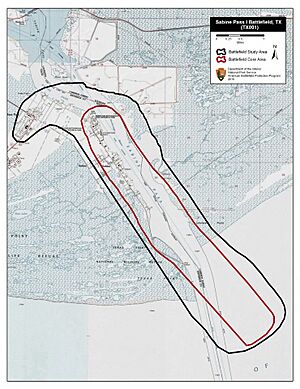First Battle of Sabine Pass facts for kids
Quick facts for kids First Battle of Sabine Pass |
|||||||
|---|---|---|---|---|---|---|---|
| Part of the Trans-Mississippi Theater of the American Civil War |
|||||||
|
|||||||
| Belligerents | |||||||
| Commanders and leaders | |||||||
| Frederick Crocker | Josephus S. Irvine | ||||||
| Units involved | |||||||
| West Gulf Blockading Squadron | Sabine Pass Garrison | ||||||
| Strength | |||||||
| 2 schooners, 1 steamer |
28 artillerists ~30 cavalry four guns Fort Sabine |
||||||
| Casualties and losses | |||||||
| none | none | ||||||
The First Battle of Sabine Pass happened on September 24–25, 1862. It was also known as the Bombardment of Fort Sabine. This battle was the first time the United States Navy attacked a Confederate fort near Sabine City, which is now Sabine Pass, Texas.
This event was part of several small fights on land and sea around the mouth of the Sabine River. It happened about a month before the Union Navy entered Galveston Bay in the Battle of Galveston Harbor. The main goals of this battle were to make the Union naval blockade stronger along the Texas coast. It also aimed to stop Confederate soldiers from moving to defend Galveston. The battle was meant to clear the way for the Union to invade Texas. Almost a year later, a bigger attempt to invade Texas happened at the Second Battle of Sabine Pass.
Contents
Why the Battle Happened
What is Sabine Pass?
Sabine Pass is a waterway where the Neches and Sabine rivers meet. This area forms the Sabine Lake estuary. The port at Sabine City was connected to a railroad line. This line ran from eastern Texas to Houston and Galveston. Even though the port and the entrance to the pass were shallow, it was used for coastal trade. It also became important for ships trying to sneak past the Union blockade.
Union Plans for Attack
In September 1862, Rear Admiral David Farragut was in charge of the West Gulf Blockading Squadron. He told Master Frederick Crocker to capture the port using his steamer, the USS Kensington. Farragut also sent Acting Master Quincy Hooper in the schooner USS Rachel Seaman to help.
On September 23, the ships arrived near the pass. They were joined by Acting Master Lewis Pennington in the mortar schooner USS Henry Janes. The captains decided that the Kensington was too big to cross the shallow bar. So, they would use only the schooners for the attack. Later that afternoon, the Rachel Seaman made it over the bar. However, the Henry Janes, which was a bit deeper, got stuck when the tide went out.
The Battle Begins
First Shots Fired
On the morning of September 24, Pennington's ship was still stuck in the mud. It was clearly visible from the fort. Pennington ordered his ship to fire, and the Rachael Seaman soon joined in. The Confederate gunners fired back, but their shots did not reach the Union ships. Most of the naval gunfire also fell short.
After five hours, the Henry Janes finally got free from the mud. It then entered the pass. Both schooners moved closer, about 1.5 miles from the fort. They began firing again at 5:30 P.M.
Confederate Defense
The Confederate forces had 28 artillerists (soldiers who operate artillery) manning their guns. They also had about 30 cavalrymen (soldiers on horseback) helping them. However, their old guns could not reach the Union ships effectively. The Confederate soldiers took cover and waited. They came out again when night fell and the bombing stopped.
After checking the damage, the Confederate commander, Major Josephus S. Irvine, decided to disable his artillery. He then ordered his troops to retreat during the night. Since the fort stopped firing during the day, Crocker tried to capture it that evening using small boats. But he could not find a way through a large oyster reef that blocked the channel.
Union Victory
The next morning, September 25, Crocker fired three shots into the fort. There was no response. He then went ashore and found the fort empty. He walked towards Sabine City and was met by a group of people who announced the town's surrender. This was the first major Texas city captured by the Union. Neither side reported any soldiers being hurt or killed in the battle.
After the Battle
Union Actions and Retreat
On September 27, 1862, three boats with 33 men traveled up the Sabine Lake. They went about 12 miles, near the mouth of Taylor's Bayou. They tried to destroy a railroad bridge, but after they left, the bridge was saved. Between September 27 and the end of the month, Crocker and the Kensington captured a British schooner named Velocity. Hooper and the Rachael Seaman also captured a schooner called Dart.
On October 3, 1862, Crocker captured a blockade runner (a ship that tries to sneak past a blockade) named Dan at the Calcasieu Pass. He used this ship to travel back up Sabine Lake to destroy the railroad bridge. Admiral Farragut promoted Crocker to Acting Volunteer Lieutenant. This was "for gallant conduct" (brave actions) in the Sabine Pass and Calcasieu Pass operations.
Later, Union leaders received reports that a large Confederate army was preparing to attack. Master Hooper, who was in charge of the area, pulled the Rachael Seaman back across the bar and into the Gulf. This meant abandoning the city and Fort Sabine. As a result, Sabine Pass, the lake, and the river returned to Confederate control.


